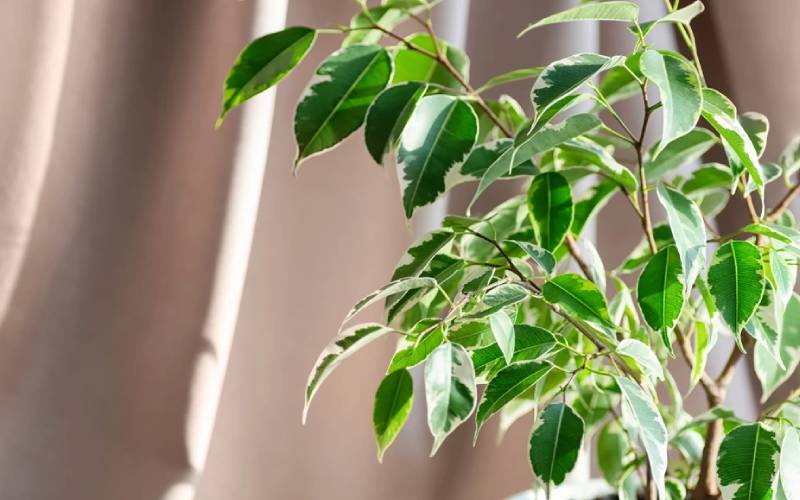
Weeping fig whose scientific name if Ficus benjamina, known as benjamin fig or ficus tree, and often sold in stores as just ficus, is a species of flowering plant in the family Moraceae, native to Asia and Australia. According to Feng Shui researchers, it is the official tree of Bangkok.
It is one of the most popular house plants in Kenya with many households placing it close to the window, popular on flower beds and the foyer. It has a dense, glossy and dark foliage, this is because of the sensitive nature of the plant.
It reacts to almost any stress like over or under watering, low light, moving it from one place to another, lack of nitrogen by shedding leaves.
Although the plant does not like being moved, it adapts to the new place in no time and shows the growth of new & healthy leaves. This is according to Hosea Kipng’etich a plant expert from lower Kabete.
How to take care of the plant
Weeping figs will drop their leaves if they are not taken care of well. The plant needs bright but indirect light and a steady temperature of at least 16 degrees Celsius to thrive.
According to Kipng’etich, “Windy, poor light levels, incorrect watering and moving the plants around can all cause the leaves to drop. Water only when the top few centimetres of compost are dry.” He says.
Where to grow
It is important to find the right spot for your weeping fig. Choose a place that has bright but indirect light, a position a few feet from a window is ideal. Make sure the plant is not in a windy spot or close to the heat of a radiator or heater in winter.
Stay informed. Subscribe to our newsletter
Temperature
Weeping figs need a steady temperature of at least 16 degrees celsius to thrive, no colder than 13 degrees celsius. In time they can become large plants, so give them plenty of room. Once you have found the right spot, try not to move the plant. Weeping figs have a tendency to lean towards the light, so you can rotate the plant occasionally to counteract this.
Watering
Once you have found the right spot for your plant, the main thing to remember is not to over water it wait until the top 2-3cm of compost is dry. After you have watered, be sure to let any excess water drain away. Use look warm water to avoid shocking the plant.
Re-potting
Weeping figs do not appreciate being re-potted frequently, it can cause them to lose their leaves. “Re-pot young plants in spring if they need it, into a slightly larger pot. Once they have reached a decent size, refresh the top layer of compost each spring. Using a fork or spoon, carefully removing the top 5cm of soil, taking care not to damage the roots, and top up with fresh ones.” Says Kipng’etich.
Pruning
You can prune your weeping fig to keep it in shape or to keep it a certain size, you can prune during the cold season when the plant is dormant. Remove any dead or dying branches first, then remove any branches that are spoiling the shape of the tree.
Common Problems
Dropping of leaves is one of the biggest problems when it comes to weeping figs. This can have many causes, the plant may need more light, or has been under- or over watered.
“Weeping figs do not like sudden changes in temperature, strong winds or strong heat from a radiator. They also dislike being moved or repotted, so try to avoid doing this too much. They may also drop their leaves if they’re being affected by pests.” Says Kipng’etich.
Large dark patches on the leaves could be sunburn, so ensure that your plant is out of direct sunlight.
Benefits of weeping fig
According to a study done on Chemical composition and biological studies on the plant, many indigenous communities in Asia use the plant to treat skin disorders, inflammation, vomiting, leprosy, malaria and cancer.
The same study found that the latex and fruit extracts of the Ficus plant contain essential oil significantly rich in antioxidants, antinociceptive, and antimicrobial properties that have multiple medicinal and insecticidal uses.
The ficus plant oil is used as an anti-dysentery remedy when used as a general tonic. The root extracts contain flavonoid contents rich in antioxidant activity that helps contain diabetes mellitus, renal failures, and degenerative diseases.
The leaves contain antimicrobial and anti-fungal properties that help to prevent the growth of deadly microbes and fungus inside the house. The leaves and twigs are used as an insect repellant.
Cost
In Kenya, it is mostly sold on the road side. The price is always between Sh1000 to Sh 4000 depending on the side of the plant and type of pot.
 The Standard Group Plc is a
multi-media organization with investments in media platforms spanning newspaper
print operations, television, radio broadcasting, digital and online services. The
Standard Group is recognized as a leading multi-media house in Kenya with a key
influence in matters of national and international interest.
The Standard Group Plc is a
multi-media organization with investments in media platforms spanning newspaper
print operations, television, radio broadcasting, digital and online services. The
Standard Group is recognized as a leading multi-media house in Kenya with a key
influence in matters of national and international interest.
 The Standard Group Plc is a
multi-media organization with investments in media platforms spanning newspaper
print operations, television, radio broadcasting, digital and online services. The
Standard Group is recognized as a leading multi-media house in Kenya with a key
influence in matters of national and international interest.
The Standard Group Plc is a
multi-media organization with investments in media platforms spanning newspaper
print operations, television, radio broadcasting, digital and online services. The
Standard Group is recognized as a leading multi-media house in Kenya with a key
influence in matters of national and international interest.






